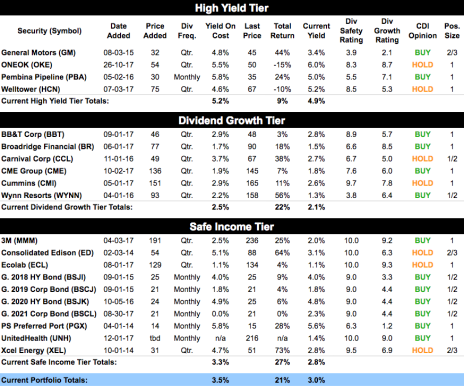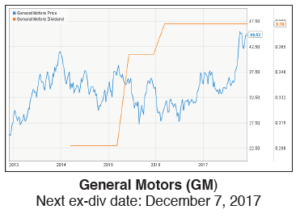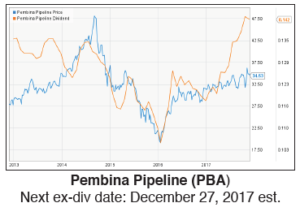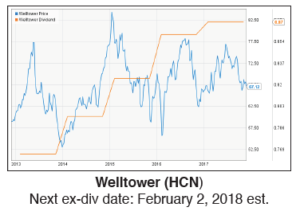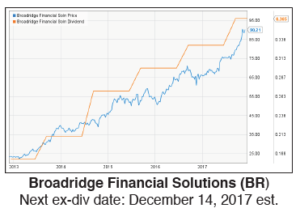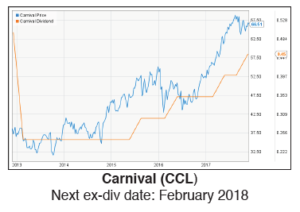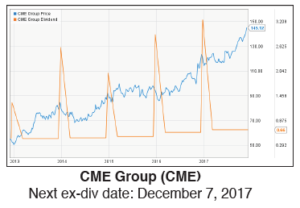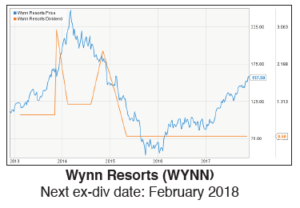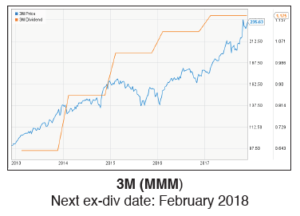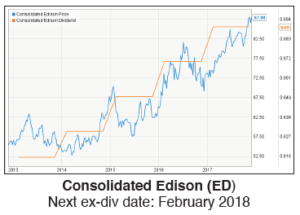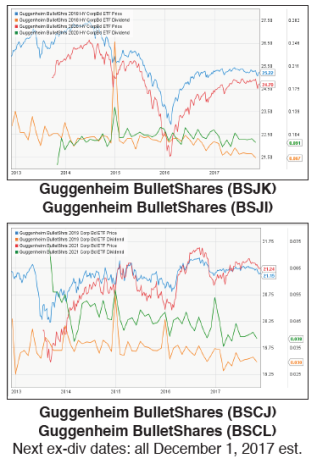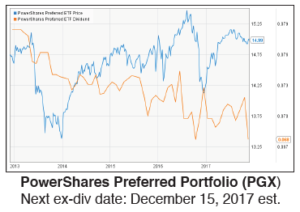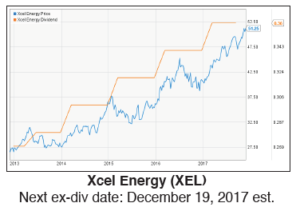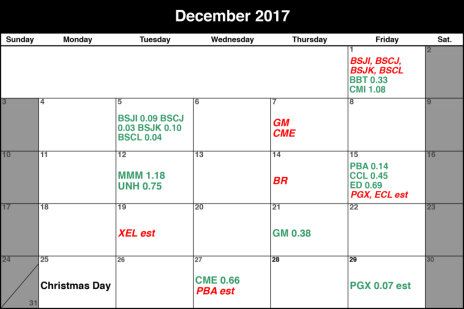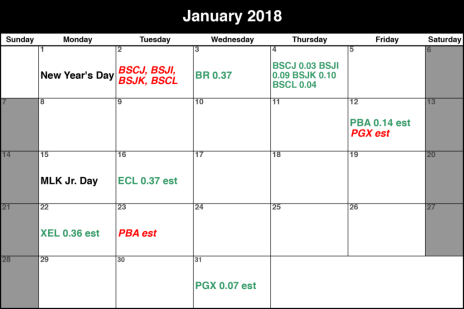In today’s issue, we’re adding a reliable new stock to the Safe Income Tier. I also review why you might want to own preferred stock in today’s educational section, and provide updates on all our holdings.
Cabot Dividend Investor 1117
[premium_html_toc post_id="141807"]
New All-Time Highs
After a quick shakeout the week before Thanksgiving, the major indexes are back at all-time highs. Strong economic data is driving outperformance in economically-sensitive sectors like consumer discretionary, materials and industrial stocks, while the “risk off” consumer staples and real estate sectors are lagging. Utilities, which usually trade in line with other conservative issues, are bucking the trend by outperforming this week, thanks to hopes that Congress is about to hand them a big tax break.
On the fixed income side, the new Fed Chair, Jerome Powell, was announced, and it seems markets expect him to deliver more of the same in terms of interest rate policy. Rates haven’t moved much since the start of October, when odds of a December rate hike first rose over 80%. Financial stocks did get a nice boost yesterday after Powell told Senators at his confirmation hearing that he thinks financial regulations are “tough enough.” Financial stocks are still the worst-performing sector of the past month.
[highlight_box]What To Do Now: I don’t have any rating changes today. I noted last week that there are some cracks in the market—our market timing gurus think we could be in some stage of a long-term top. But for now, the trend remains firmly up, so it’s time to be making money. If you’re underinvested, put your cash to work in some of our Buy-rated recommendations. In the High Yield Tier, General Motors (GM) finally has great momentum. For dividend growth investors, Broadridge (BR), CME Group (CME) and Wynn Resorts (WYNN) are all looking like winners. And for safe income investors, we have a new addition today. [/highlight_box]
Featured Buy
UnitedHealth Group (UNH)
This month we’re adding UnitedHealth Group, a massive U.S. health care company, to the Safe Income Tier. The stock has low volatility and strong Dividend Safety and Growth Scores, and analysts have high earnings growth expectations.
The Company
Minnesota-based UnitedHealth is the world’s largest health care company. About 63% of revenues come from the company’s UnitedHealthcare segment, which provides health insurance through employer-sponsored, individual, Medicare, Medicaid and military plans. Another quarter of revenues are generated by the company’s pharmacy benefit manager, OptumRx. The remainder of revenues come from OptumHealth, which provides health services on a contract basis as well as through its own health centers, and OptumInsight, a provider of technology to the health care industry. (OptumInsight is currently the smallest contributor to revenues, but boasts margins of around 20%.)
The company’s vertical and horizontal integration give UnitedHealth an advantage in delivering healthcare profitably. For example, when members of UnitedHealthcare insurance plans are treated at OptumHealth medical centers, the revenue stays entirely within the company. UnitedHealth’s operating margins are a rock solid 7%, and the company’s balance sheet is strong.
Revenue growth is high and steady—revenues have increased in each of the past 10 years, by an average of 9% per year. In the latest quarter, revenues rose almost 9% year-over-year, while adjusted EPS grew 23%. Analysts expect EPS growth to hit 24% this year before returning to a closer-to-average rate of 8% in 2018. Analysts’ 2018 estimates include the impact of the Health Insurer Tax, which was suspended in 2017. Over the next five years, analysts expect EPS growth to average 15% per year.
Most of that growth will come from the addition of new customers, as more people join Medicare and the company wins new Medicaid, military and corporate contracts. UnitedHealth Group is leading the way in introducing value-based contracts, which pay health providers (including some OptumHealth doctors) for outcomes rather than for each procedure performed. If preferences continue to shift toward value-based contracts, customers will continue to flock to UnitedHealth Group. In addition, UnitedHealth plans to continue to grow through acquisitions, international expansion and by opening new OptumHealth centers.
The Dividend
UnitedHealth has paid dividends since 1990, but payments were small and annual until 2009. The company started making quarterly payments and got serious about the dividend in 2010, and has increased the dividend every year since. The last five increases have averaged a generous 29% each, but UnitedHealth’s payout ratio remains a reasonable 31%.
UnitedHealth’s dividend history and recent commitment to dividend increases earn the stock a perfect Dividend Safety Rating of 10.0 and an excellent Dividend Growth Rating of 9.0 (both out of 10).
The Stock
UNH’s current uptrend started in early 2016, and the stock has advanced 85% over the past two years. UNH gapped up from 193 to 203 after reporting earnings in October, and has been consolidating at a high base around 210 since the start of the month.
UNH has low volatility—the stock barely reacted to the CVS-Aetna merger offer in October, and shrugged off most of Republicans’ Obamacare repeal efforts over the past year. That, plus its perfect Dividend Safety Rating, make the stock appropriate for our Safe Income Tier, and we’ll be adding UNH at the stock’s average price on Friday, December 1.
| UnitedHealth Group (UNH) | ||
|---|---|---|
| Price: 216 52-week range: 150.00-216.31 Market cap: $208.98 billion P/E: 25 | Current yield: 1.4% Annual dividend: $3.00 Most recent dividend: $0.75 Dividend Safety rating: 10 Dividend Growth rating: 9.0 | |
| Dividends since: 1990 Consecutive years of increases: 7 Qualified dividends? Yes | Payment Schedule: Quarterly Next ex-dividend date: November 30, 2017 | |
Portfolio at a Glance
Portfolio Updates
High Yield Tier
The investments in our High Yield tier have been chosen for their high current payouts. These ?investments will often be riskier or have less capital appreciation potential than those in our other ?two tiers, but they’re appropriate for investors who want to generate maximum income from their? portfolios right now.
BUY – General Motors (GM 45 – yield 3.4%) – GM has been trending up since mid-August, when investor excitement about the company’s “future of mobility” initiatives began to outweigh analyst fears about “peak auto.” The company will hold a webcast on autonomous vehicles tomorrow, which will likely add to investors’ excitement. Still, the stock is far from overbought: GM spent three weeks consolidating after its latest gap up, and recently completed a brief pullback to its 50-day moving average. Plus, the stock remains deeply undervalued at a P/E of 9.3, despite beating estimates by a large margin in each of the last four quarters. While the stock’s yield has come down significantly since we added it to the portfolio, making it less attractive to high-yield investors, I think risk-tolerant investors interested in medium-term capital gains can buy GM right here.
HOLD – ONEOK (OKE 50 – yield 6.0%) – Crude oil prices are at a two-and-a-half year high but U.S. energy stocks continue to lag after a significant oil leak shut down the Keystone pipeline in South Dakota. ONEOK’s pipelines and processing facilities deal with natural gas and natural gas liquids, not oil, but the stock is still affected by moves in the energy sector, and particularly high yield energy stocks. While the spill seems responsible for the latest pullback, many pipeline stocks and other high yield energy stocks, including MLPs, have been struggling since late October. The near-certainty of a December rate hike could be contributing, since higher interest rates reduce demand for high yield stocks, but interest rates have actually come down over the past 30 days. Regardless of the reason, the weakness in the sector and in OKE, in particular, is reason for concern, and I moved OKE to Hold last week. For now, the stock remains just above 50, where it found support back in August, and our loss remains a tolerable 15% (as always, use your own loss limit if your portfolio). But we won’t hesitate to cut OKE loose if the bottom falls out from the stock. For now, risk-tolerant high yield investors can hold.
BUY – Pembina Pipeline (PBA 35 – yield 5.0%) – Canadian pipeline stock PBA is holding up better than its natural gas companion in our portfolio, OKE. PBA pulled back to its 50-day moving average earlier this month, but remains well within the middle of its trading range. Longer-term, PBA is trending up gradually above its 40-week moving average. High yield investors looking to add monthly income to their portfolio can buy a little here. (Note that the dividend line in the chart at left is choppy because Pembina’s dividend is declared in Canadian dollars, so U.S. investors will see their payout vary with exchange rates.)
HOLD – Welltower (HCN 67 – yield 5.2%) – HCN has another week of sideways action under its belt, strengthening the case that the stock’s late October pullback to 65 marked a bottom for now. Still, I’m going to keep the health care REIT on Hold until it displays some upward momentum. Long-term, the company’s portfolio of senior housing and outpatient properties should see strong tailwinds from the dual trends of the aging U.S. population and the fight to lower health care spending. And the stock’s 5.2% yield is competitive. High yield investors can hold.
Dividend Growth Tier
To be chosen for the Dividend Growth tier, investments must have a strong history of dividend increases and indicate both good potential for and high prioritization of continued dividend growth.
BUY – BB&T Corp (BBT 48 – yield 2.8%) – After two weeks muddling around near 46, just below its 50-day moving average, BBT popped with the rest of the bank stocks yesterday. Long-term, BBT is in a choppy uptrend, but momentum is intermittent. Still, the company has a 30-year dividend history and a portfolio of high-quality loans, and the stock has support at 44 and 42. Long- and medium-term dividend growth investors can Buy a little here.
BUY – Broadridge Financial Solutions (BR 90 – yield 1.5%) – BR, which has advanced in 14 of the past 15 weeks, remains in a strong uptrend, though it’s currently consolidating its post-earnings gains just under 90. Broadridge provides a variety of solutions to the financial industry, including technology, software and investor communications services. Analyst estimates for this year and next have both been rising steadily, and analysts currently expect Broadridge to deliver 19% earnings growth for its current fiscal year, which ends in June 2018. Dividend growth investors can buy a little here, or try to wait for a pullback to the stock’s rising 50-day moving average, currently around 85.
HOLD – Carnival (CCL 67 – yield 2.7%) – CCL continues to chop around between 64 and 68, though its range has narrowed slightly. Current- and next-year earnings estimates for the cruise company have come down slightly since Hurricane Maria damaged numerous Caribbean ports, which could put a damper on CCL for the next few months. But the long-term uptrend in demand for cruises is intact, so we’re holding on to the remainder of our CCL for now to see if the stock delivers a second act. (We took profits back in September, selling half our shares for a 38% return.)
BUY – CME Group (CME 145 – yield 1.8%) – After a normal pullback to its 50-day in late October, CME has resumed its steady uptrend. The company has been in the news for introducing bitcoin futures, which will start trading in a couple weeks. Bigger picture, CME is benefiting from the steady growth of the financial industry and the drive to securitize and trade everything. Dividend growth investors can buy here or on pullbacks toward the 50-day, currently around 137. CME typically pays large special dividends at the end of each year, visible on the chart at left.
HOLD – Cummins (CMI 165 – yield 2.6%) – Since dropping 4% in one day after Tesla revealed its new electric semi-truck mid-month, CMI has traded sideways between 160 and 165. That tells me there’s real fear about how the increased competition will impact Cummins, but there isn’t a ton of selling pressure in the stock at these levels. Still, CMI has struggled since reporting earnings on October 31, declining from 180 to 160 in a series of damaging gaps down. The stock’s long-term uptrend remains intact, so thus far, we’re treating this as a normal pullback. But we’ll reconsider if the stock violates its 40-week moving average or the 150 level, where it bottomed in August.
BUY – Wynn Resorts (WYNN 158 – yield 1.3%) – WYNN has been consolidating since our last update, but continues to trade near 52-week highs. The stock is in a strong uptrend and earnings estimates are excellent. Wynn hasn’t increased its dividend since VIPs started to return to Macau, so investors likely still have a big hike or two to look forward to. Dividend growth investors can buy here.
Safe Income Tier
The Safe Income tier of our portfolio holds long-term positions in high-quality stocks and other investments that generate steady income with minimal volatility and low risk. These positions are appropriate for all investors, but are meant to be held for the long term, primarily for income—don’t buy these thinking you’ll double your money in a year.
BUY – 3M (MMM 236 – yield 2.0%) – After a normal two-week pullback, MMM is moving back toward the all-time high the stock hit at the end of October. Industrials like 3M led the market higher this fall, but pulled back this month. However, the sector is now rebounding again amid strong economic data. Current and next-year earnings estimates for 3M, which makes technology and products used in industries from health care to road building, have been steadily rising. EPS are now expected to grow 11% in 2017. Safe income investors who don’t own MMM yet can buy some here.
HOLD – Consolidated Edison (ED 88 – yield 3.1%) – After a short, one-week pullback, ED is trending up again. The New York-area utility is a solid source of safe income and long-term gains, but is rated Hold until a longer correction presents us with a better buy point. If Republicans’ tax cut for big businesses fails, we could see such an opportunity, although ED has been remarkably resilient recently. In any case, safe income investors can hold.
HOLD – Ecolab (ECL 134 – yield 1.1%) – Ecolab is a Dividend Aristocrat that provides cleaning- and liquids-related technologies and services to numerous industries, from oil refiners to restaurants. This year’s results will be impacted somewhat by Hurricane Harvey, which forced Houston-based Ecolab to shut down some plants. Longer-term, growth should remain strong and steady, as economic growth accelerates and businesses continue to move toward more sustainable, environmentally-friendly processes. Technically, ECL is trading in a long-term horizontal range between about 130 and 135. Safe income investors can hold.
BUY – Guggenheim BulletShares 2018 High Yield Corporate Bond ETF (BSJI 25 – yield 4.0%)
BUY – Guggenheim BulletShares 2019 Corporate Bond ETF (BSCJ 21 – yield 1.8%)
BUY – Guggenheim BulletShares 2020 High Yield Corporate Bond ETF (BSJK 25 – yield 4.8%)
BUY – Guggenheim BulletShares 2021 Corporate Bond ETF (BSCL 21 – yield 2.3%)
These four funds make up our bond ladder, which is a conservative strategy for generating income. The funds pay distributions monthly, and mature at the end of the year in their name, at which point Guggenheim disburses the net asset value of the ETF back to investors. That means the funds won’t (permanently) lose value when interest rates rise. If you’d like to construct your own bond ladder, you can use a mix of investment-grade and high yield funds, as we have, or pick one or the other. The high yield funds own junk-rated debt and yield more, of course, but are also more likely to see some of their holdings default (and to be volatile when credit conditions get dicey). If you roll the proceeds into a longer-dated fund every time a fund matures, you’ll create a reliable income stream that can rise over time with interest rates.
BUY – PowerShares Preferred Portfolio (PGX 15 – yield 5.6%) – PGX is an ETF that holds preferred shares. It doesn’t have capital appreciation potential, but trades in a low-volatility range between 14 and 16 and pays monthly dividends of about seven cents per share. It’s currently trading just a hair above 15, so I’ll keep it on Buy for investors who want to add a source of reliable monthly income to their portfolios. For more on why you might want to own preferred shares, read this month’s educational section at the end of the issue.
HOLD – Xcel Energy (XEL 51 – yield 2.8%) –XEL is near all-time highs, so I’m keeping it on Hold for now. But investors looking for long-term gains and safe income will find them with this Minnesota-based electric utility, which is also a U.S. leader in utility-scale renewable projects.
Dividend Calendar
Ex-Dividend Dates are in RED and italics. Dividend Payments Dates are in GREEN. See the Guide to Cabot Dividend Investor for an explanation of how dates are determined and what estimated dates mean.
Preferred Shares: A Source of High and Reliable Income
The last decade has been challenging for fixed income investors, as the yields offered by all types of issuers have dwindled amid persistently high demand for safe, income-generating securities. Preferred shares are one pocket of the fixed income market where investors can still typically find reasonable yields without taking on undue risk. In part because the preferred market is much smaller than the equity and bond markets—about 1% and 3% of each, by market cap—preferred stock yields have remained relatively higher than the yields on other types of corporate debt.
Despite its name, preferred stock doesn’t represent or confer ownership—it’s debt, like a bond or loan. Also like bonds, preferreds have fixed distribution rates. So you’d only buy a preferred for steady income, not capital gains.
That said, preferred stock can generate a very steady income. The yields are usually between 4% and 8%. And preferred shareholders are usually better protected—both in and out of bankruptcy—than common stock holders.
Most preferred stock is issued at a par value of $25, with a fixed coupon rate. The coupon rate times the par value determines the annual distribution, which won’t change over time. But the preferred’s yield may vary above or below the coupon rate, depending on whether the preferred is trading above or below par.
Most preferreds issued at $25 will trade in a range between $23 and $27, depending on market conditions and investor sentiment about the company and the preferreds. If a preferred is trading above par, investors think the yield is attractive enough to pay a premium to the security’s face value. If it’s trading significantly below par, investors may have concerns about the company’s creditworthiness.
But generally, preferred stock dividends are very safe because they are paid before dividends on the common stock. And preferreds are above the common stock in the capital structure, so in bankruptcy, preferred shareholders’ claims on the company’s assets are superior to ordinary stockholders’ (although in practice, both usually get nothing).
Preferred stock dividends are also usually cumulative, meaning that if the company doesn’t pay some (or all) of its promised distributions, investors will receive them at a later date. The unpaid portion is considered “dividends in arrears” and must be paid before any other dividends.
Most preferreds are also callable. Callable preferreds will have a call price (usually also $25) and a call date. On or after the call date, the company has the right to buy back the preferreds from investors for the call price. Call dates are usually set five years after the issue date.
Preferred shares will typically be called if the company can save money by issuing new debt at a lower interest rate, just like refinancing your mortgage at a lower rate. An interest rate that is even half a percent lower is enough to entice most companies to refinance. Typically, companies can issue new debt at about the same yield as their existing preferreds trade.
But the company has no obligation to call its preferreds, and many preferreds are not called for years after their call dates.
If your preferreds are called, you’ll receive the call price of the shares plus any unpaid dividends. Having your preferred called can be a good thing if you bought it below the call price, and a bad thing if you paid too much for it.
If you’re considering buying a preferred above its call value but aren’t sure if it’s a good idea, you can use a calculator to check your yield to call. For example, let’s say you’re considering paying $26 per share for a preferred that pays $2 a year in dividends but is callable at $25 in two years. If the preferred is called, you’ll lose $1 per share. But you’ll earn $4 in dividends in the meantime. Thus, your yield to call (average annual return until the call date) would be 5.82%, quite a bit lower than the current yield of 7.69% (= $2/$26) but still decent. You can figure out your yield to call using a calculator like the one at https://www.preferred-stock.com/calculator_ytc.php.
Some preferreds also have maturity dates, which is a date between 30 and 100 years after the issue date when the preferreds must be called. Preferreds that don’t have maturity dates are called perpetual.
And some preferred stock is convertible, meaning it can be converted into ordinary stock on or after a given date. This option gives preferred stockholders more potential upside, although convertible preferreds will often trade at a premium as a result.
One downside to preferred stock is that preferred holders usually don’t have voting rights as common stockholders do.
In addition, preferred ticker symbols are not standardized—they usually take the form of the issuing company’s stock symbol followed by a letter indicating the preferred series, but some also include dashes, dots or a ‘P’ for preferred—so always double check to make sure you’re buying the specific issue you want.
Lastly, while preferred stock is theoretically as easy to buy and sell as common stock, most preferred stocks are very lightly traded. Use limit orders when buying so you don’t pay more than you want to, and avoid preferred stocks trading less than 4,000 shares daily, on average.
You may also want to buy an ETF that holds preferred shares instead of individual issues, as we’ve done in the Safe Income Tier of the Cabot Dividend Investor portfolio.
The iShares U.S. Preferred Stock ETF (PFF), PowerShares Preferred Portfolio (PGX) and SPDR Wells Fargo Preferred Stock ETF (PSK) ETFs all have low expense ratios, good yields, diversification and adequate volume. The largest and most popular of the funds is the iShares offering, PFF. However, PFF’s holdings have the lowest overall credit quality of the three funds. The PowerShares and SPDR offerings limit themselves to investment-grade preferreds to minimize credit risk. Though any of the three are a fine source of regular income, in our portfolio, we opted to go with the PowerShares ETF because it pays dividends monthly.
We don’t currently hold any individual preferred shares in our portfolio, but investors looking to add individual preferreds to their portfolio can start by looking for preferreds issued by companies they already own. Currently, only two of the companies in our portfolio have outstanding preferreds. Welltower (HCN) has one outstanding convertible preferred, but because the stock is currently trading above the conversion price of $59, the preferred trades more or less in-line with the stock.
The other company is BB&T Corp (BBT), which is unsurprising since preferreds issued by financials make up at least 85% of the market.
BB&T has five classes of outstanding preferred stock, all perpetual, callable and with coupon rates between 5% and 6%. The series D, E and F preferreds are already past their call dates, but have not been called, while the G and H shares are callable in 2018 and 2021, respectively. While BBT-H has the longest time remaining until its call date, the shares are currently trading above par value, around $27, so they offer a yield to call of only 3.12%. The D, E and F shares are all trading slightly above $25. All the shares pay distributions on the first of March, June, September and December, and the distributions are eligible for the 15% tax rate.
If you’re interested in adding individual preferreds to your portfolio, you’ll find a wealth of information about individual preferred stocks at quantumonline.com, including annual distributions, call and maturity dates, whether they’re cumulative or convertible, and whether their dividends qualify for the 15% dividend tax rate.
[premium_html_footer]
Your next issue will be published December 20, 2017
Cabot Wealth Network • 176 North Street • Salem MA 01970 • 978-745-5532
Neither Cabot Wealth Network nor our employees are compensated by the companies whose stocks we recommend. Sources of information are believed to be reliable, but are in no way guaranteed to be complete or without error. Recommendations, opinions or suggestions are given with the understanding that subscribers acting on the information assume all risks. © Cabot Wealth Network. Copying and/or electronic transmission of this report is a violation of U.S. copyright law. For the protection of our subscribers, if copyright laws are violated, the subscription will be terminated. To subscribe or for information on our privacy policy, call 978-745-5532, visit www.cabotwealth.com or write to support@cabotwealth.com.
[/premium_html_footer]



